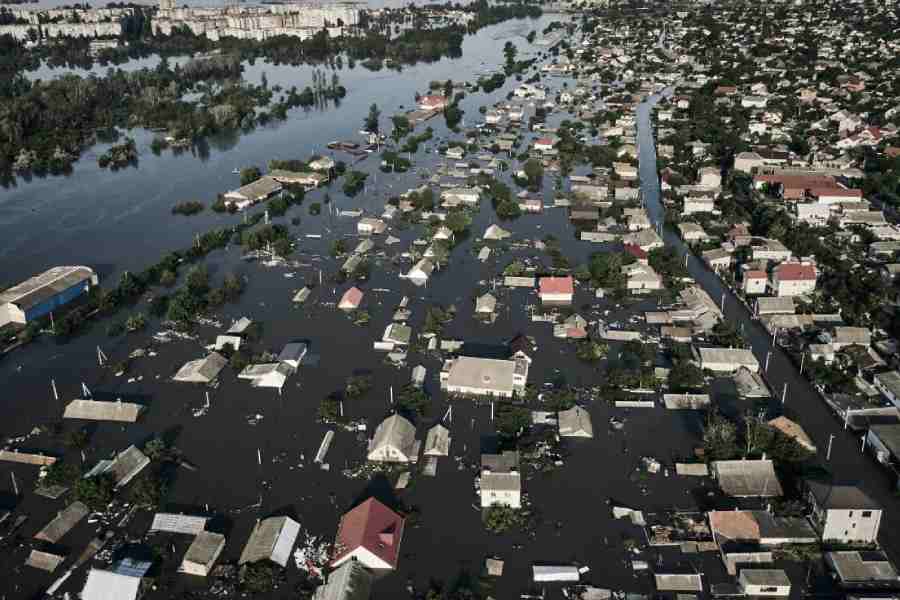The view from villagers’ gardens on the northern shore of the Kakhovka Reservoir has changed significantly in the four days since an explosion destroyed the nearby dam and the waters receded.
Mud flats stretch for hundreds of yards, and a long sandbar has emerged from the water reaching out across the bay. Europe’s largest nuclear power plant, only 6km across the water on the southern shore, where it is under Russian military control, appears closer. The water has already dropped below the critical level to resupply water to the plant, Ukrainian officials said.
In communities downriver, the water unleashed by the burst dam flooded homes and swept away property and livestock within hours of the explosion. For those living upstream, the disaster has unfolded in slow motion, the reservoir dropping three to four feet a day.
“Everything will die,” said Tetyana, 64, as she walked through her fruit and vegetable garden, with young tomato plants on her left and red currant and black currant bushes on her right.
The taps had run dry in the morning in her village, Prydniprovske, said Tetyana, who like other residents withheld their surnames for security reasons. She had just managed to do a load of washing in time. And the pipe that she used to water the vegetables had also dried up.
Built 75 years ago, the Kakhovka Reservoir, the largest body of fresh water in Ukraine, is the life and livelihood of communities across a huge region. Its water feeds everything from small homes to large industries, with gardens, vineyards, shipping businesses and steel plants all reliant on the reservoir.
Now, all are under threat. The towns and villages that grew up around the reservoir face hardship, even extinction, endangering a critical pillar of Ukraine’s economy.
“It’s probably the biggest ecological disaster in the history of independent Ukraine,” said Oleksii Vasyliuk, the head of the board of the Ukrainian Nature Conservation Group, referring to the period since the breakup of the Soviet Union more than 30 years ago.
The stocks of freshwater fish, he said, would most likely wash out to sea and die in the salt water. The shellfish would perish in the mud as the waterway dried out.
Pollution from industrial plants in the surrounding area, which had mostly settled on the floor of the reservoir, would now be disturbed. While some would be washed downstream into the Black Sea, much would be exposed and, as the mud dried, the pollution would be dispersed by the wind.
Officials talk of the need to wait until the river stabilises. By the weekend, they expect the reservoir to have mostly emptied and the remaining water to have settled behind what is left of the dam.
“It is difficult to predict,” said Viktor Nedria, the head of the village council of Maryanske. “It depends on the level of destruction. If the lower part of the dam is there, then we will have some water. If it is all gone, then we will lose everything.”
For the immediate future, their supplies are sufficient. Villagers had stored water that could last for days. Local authorities also plan to truck water into communities. But over the longer term, locals are contemplating immense losses to their livelihoods.
“They understand,” Nedria said. “The questions are silent, but you see it in their eyes.”
Officials, businessmen and scientists are already calculating the lasting and disastrous consequences. More than a half-million hectares of farmland, which depends on the reservoir for irrigation, would be put out of production, the agriculture ministry said in a statement last week. The southern region of Kherson would be hardest hit, as well as the adjoining regions of Zaporizhzhia and Dnipro.
“The fields of southern Ukraine may turn to deserts as early as next year,” the ministry said. “Everything will dry out, and there will be no harvest,” said Ivan, 32, a trader from the city of Kryvyi Rih.
One of the oldest vineyards in Ukraine, Stoic Winery, which lies on the banks of the reservoir just above the Khakovka dam, is directly affected.
Andrii Strilets, the winery’s chief executive, said he would have to find other irrigation sources farther away. Most of all, he fears that a change in the microclimate from the loss of the reservoir will endanger the future of some of his grapes.
“In a week, I will know what will happen to which kind of grape, which one will not survive,” he said. “We had some unique sorts. They needed moist air from the water.”
The Kakhovka Dam was the gateway to the Dnipro river, a broad and historic waterway that was until last year a busy transport route for grain shipments and other material. The nearby ports used to handle 12 million tonnes per year of cargo, mostly grain for export, but also construction materials and other produce, he said, and the terminals alone employed 1,000 people.
More than a dozen transport terminals and two river ports have been rendered unusable by the draining of the reservoir, said Yevhenii Ihnatenko, the head of the Shipping Administration.
The locks and sluice gates that barges and other vessels used to pass through the dam have been blocked by broken stone and debris from the explosion, so there is no way for them to traverse the river, he added.
Concern is also rising for the nuclear power plant across the water. By Thursday evening, the reservoir’s waters had fallen below the lowest point for pumps to operate normally to supply the plant.
3 killed
Three people were killed on Sunday and 10 were wounded when Russian forces attacked a boat carrying evacuees from flooded occupied territory to the Ukrainian-controlled city of Kherson, the regional governor said, Reuters reported.
New York Times News Service











